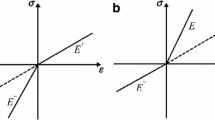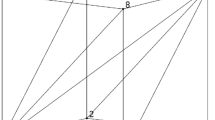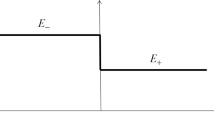Abstract
The bimodulus material is a classical model to describe the elastic behavior of materials with tension–compression asymmetry. Due to the inherently nonlinear properties of bimodular materials, traditional iteration methods suffer from low convergence efficiency and poor adaptability for large-scale structures in engineering. In this paper, a novel 3D algorithm is established by complementing the three shear moduli of the constitutive equation in principal stress coordinates. In contrast to the existing 3D shear modulus constructed based on experience, in this paper the shear modulus is derived theoretically through a limit process. Then, a theoretically self-consistent complemented algorithm is established and implemented in ABAQUS via UMAT; its good stability and convergence efficiency are verified by using benchmark examples. Numerical analysis shows that the calculation error for bimodulus structures using the traditional linear elastic theory is large, which is not in line with reality.










Similar content being viewed by others
References
Medri, G.: A nonlinear elastic model for isotropic materials with different behavior in tension and compression. J. Eng. Mater. Technol. 104, 26–28 (1982)
Qu, C.Z.: Deformation of geocell with different tensile and compressive modulus. J. Geotech. Geoenviron. 14, 1–14 (2009)
Du, Z.L., Zhang, Y.Z., Zhang, W., et al.: A new computational framework for materials with different mechanical responses in tension and compression and its applications. Int. J. Solids Struct. 100–101, 54–73 (2016)
Ambartsumyan, S.A.: Elasticity theory of different moduli. China Railway Publishing House, Beijing (1986). (in Chinese)
Du, Z.L., Zhang, W.S., Zhang, Y.P., et al.: Structural topology optimization involving bi-modulus materials with asymmetric properties in tension and compression. Comput. Mech. 63, 335–363 (2019)
Zhang, Y.P.: High performance algorithm development for materials with different moduli in tension and compression and its application. [Master’s Thesis], Dalian University of Technology, Dalian (2016). (in Chinese)
Timoshenko, S.: Strength of materials. Van Nostrand, Princeton (1941)
Ambartsumyan, S.A., Khachatryan, A.A.: Basic equations in the theory of elasticity for materials with different stiffness in tension and compression. Mech. Solids 1, 29–34 (1966)
Ambartsumyan, S.A., Khachartryan, A.A.: The basic equations and relations of the different-modulus theory of elasticity of an anisotropic body. Mech. Solids 4, 48–56 (1969)
Jones, R.M.: Stress-strain relations for materials with different moduli in tension and compression. AIAA J. 15, 16–23 (1977)
Bert, C.W.: Models for fibrous composites with different properties in tension and compression. J. Eng. Mater. Technol. 99, 344 (1977)
Bert, C.W., Gordaninejad, F.: Transverse shear effects in bimodular composite laminates. J. Compos. Mater. 17, 282–298 (1983)
Vijayakumar, K., Rao, K.P.: Stress-strain relations for composites with different stiffnesses in tension and compression. Comput. Mech. 2, 167–175 (1987)
He, X.T., Pei, X.X., Sun, J.Y., et al.: Simplified theory and analytical solution for functionally graded thin plates with different moduli in tension and compression. Mech. Res. Commun. 74, 72–80 (2016)
Yao, W.J., Ye, Z.M.: Analytical solution for bending beam subject to lateral force with different modulus. Appl. Math. Mech. 25, 1107–1117 (2004)
Du, Z.L., Guo, X.: Variational principles and the related bounding theorems for bi-modulus materials. J. Mech. Phys. Solids 73, 183–211 (2014)
Zhang, Y.Z., Wang, Z.F.: The finite element method for elasticity with different moduli in tension and compression. Comput. Struct. Mech. Appl. 6, 236–246 (1989). (in Chinese)
Yang, H.T., Wu, R.F., Yang, K.J., et al.: Solution to problem of dual extension compression elastic modulus with initial stress method. J. Dalian Univ. Technol. 32, 35–39 (1992). (in Chinese)
Liu, X.B., Zhang, Y.Z.: Modulus of elasticity in shear and accelerate convergence of different extension compression elastic modulus finite element method. J. Dalian Univ. Technol. 40, 527–530 (2000)
He, X.T., Zheng, Z.L., Sun, J.Y., et al.: Convergence analysis of a finite element method based on different moduli in tension and compression. Int. J. Solids Struct. 46, 3734–3740 (2009)
Zhang, H.W., Zhang, L., Gao, Q.: An efficient computational method for mechanical analysis of bimodular structures based on parametric variational principle. Comput. Struct. 89, 2352–2360 (2011)
Huang, T., Pan, Q.X., Jin, J., et al.: Continuous constitutive model for bimodulus materials with meshless approach. Appl. Math. Model. 66, 41–58 (2019)
Zhang, L., Zhang, H.W., Wu, J., et al.: A stabilized complementarity formulation for nonlinear analysis of 3D bimodular materials. Acta. Mech. Sin. 32, 481–490 (2016)
Acknowledgements
The authors highly appreciate Prof. X. Guo and Dr. Z.L. Du from Dalian University of Technology for helpful discussion and advice. This research was supported by the National Natural Science Foundation of China (Grant 51908071), Scientific Research Project of Education Department of Hunan Province (Grant 18C0194), and Open Fund of Key Laboratory of Road Structure and Material of Ministry of Transport, Changsha University of Science & Technology (Grant kfj170303).
Author information
Authors and Affiliations
Corresponding author
Appendices
Appendix A
1.1 Deduction of the constitutive equation Eq. (3)
The direction cosines obey the following relationships:
The strain components in one coordinate system are given as
Substitution of Eq. (1) into the constitutive Eq. (A.2) yields
Similarly, the remaining equations can be obtained in the same way.
Appendix B
2.1 The ratios \(l_{2} /m_{1}\), \(m_{3} /n_{2}\), and \(n_{1} /l_{3}\)
Note that the direction cosines satisfy the following equations:
When l1, m2, n3 → 1; l2, l3, m1, m3, n1, n2 → 0, we have
From Eqs. (a) and (d) in (B.2), we have
and from Eqs (b) (c) in (B.2), it is obvious that
Similarly, from Eqs. (e) and (f) in (B.2), one has
Combining Eqs. (B.3)–(B.5) and letting \(\mathop {\lim }\limits_{\begin{subarray}{l} \;\;\;\;\;\;\;l_{1} ,m_{2} ,n_{3} \to 1 \\ l_{2} ,l_{3,} m_{1} ,m_{3} ,n_{1} ,n_{2} \to 0 \end{subarray} } l_{2} /m_{1} = k\), we have
From Eqs. (B.3) to (B.6), it can be seen that the three shear moduli have similar form to k. Consider
Equations (a′) and (d′) give
Substitution of Eq. (B.6) into the above equation yields
Thus
Similarly, from Eqs. (b′) and (e′), we have
and from Eqs. (c′) and (f′)
Combining Eqs. (a′) and (e′) and taking the limits, we obtain
Similarly, from Eqs. (a′) and (f),
and from Eqs. (b′) and (d′) and from Eqs. (b′) and (f′),
Also, from Eqs. (c′) and (d′) and from Eqs. (c′) and (e′), one has
Considering Eq. (B.6), Eqs. (B.8)–(B.16) yield
It can be seen from the above formula that the direction cosines have the same signs (positive or negative) or different signs at the same time. l3, m1, and n2 are infinitesimally small quantities of the same order, as are l2, n1, and m3. In addition, the limit can be obtained as
As the shear stress is zero on the principal stress surface, i.e.,
Then, it can be obtained from Eqs. (B.19) and (B.20) that
Combining Eqs. (B.18) and (B.21) yields
Therefore, we have
Since the above equation is true for any magnitude principal stresses \(\sigma_{\alpha }\) and \(\sigma_{\beta }\), one has\(\mathop {\lim }\limits_{\begin{subarray}{l} \;\;\;\;\;\;\;l_{1} ,m_{2} ,n_{3} \to 1 \\ l_{2} ,l_{3,} m_{1} ,m_{3} ,n_{1} ,n_{2} \to 0 \end{subarray} } l_{2} + m_{1} = 0,\)which leads to
In the same way, we have
Rights and permissions
About this article
Cite this article
Pan, Q., Zheng, J. & Wen, P. Efficient algorithm for 3D bimodulus structures. Acta Mech. Sin. 36, 143–159 (2020). https://doi.org/10.1007/s10409-019-00909-3
Received:
Revised:
Accepted:
Published:
Issue Date:
DOI: https://doi.org/10.1007/s10409-019-00909-3




